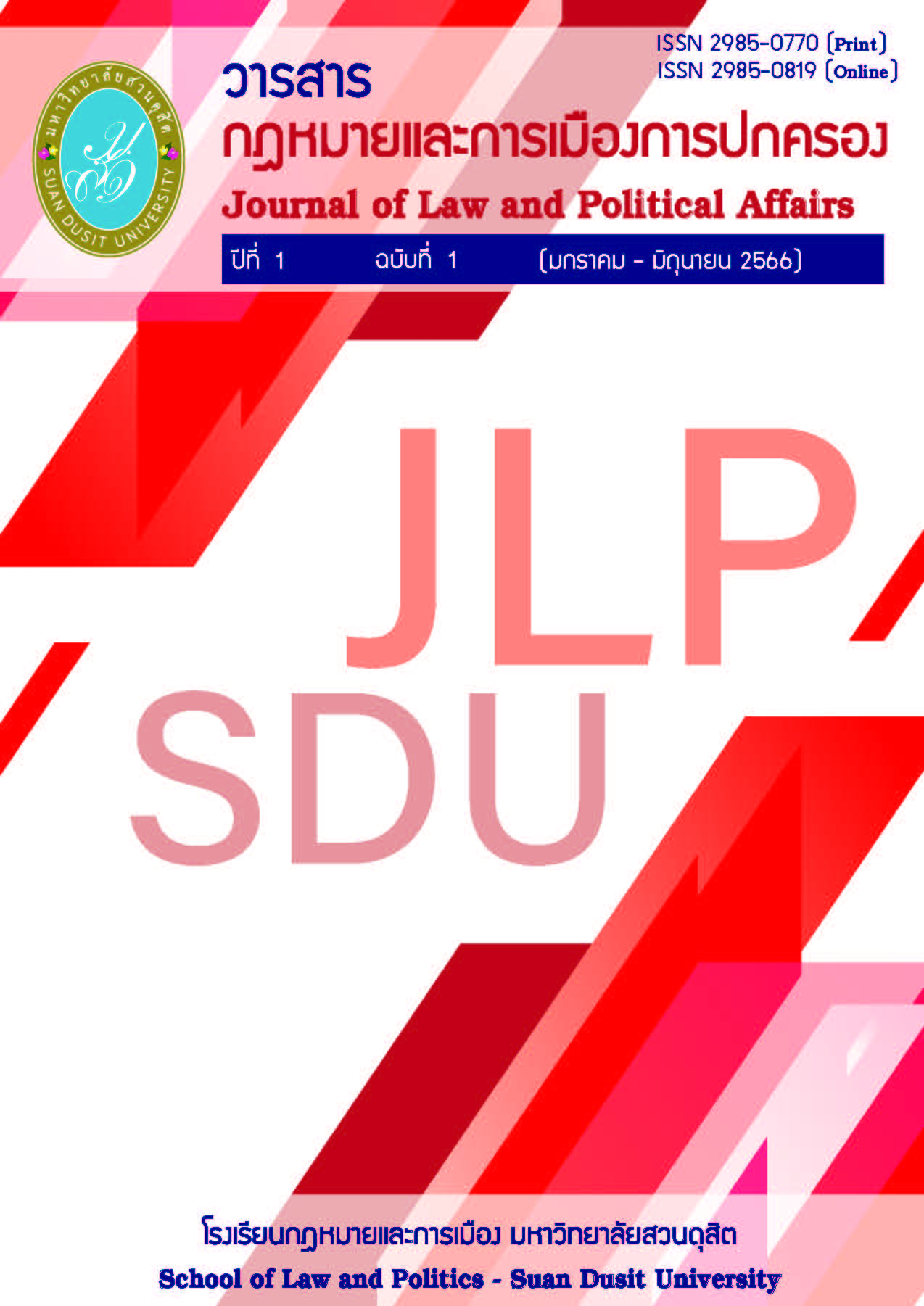Collection data on juvenile delinquency in forensic science investigation
Laksika Chunchomkin
Keywords:
CHILD AND JUVENILE, DATA TENDENCY, CRIMINAL PROFILINGAbstract
The objective of this research were to compare and study Collection criminal profiling of child and Juvenile during the year 2017-2020 and Qualitative Research from 397 Data from Police Station in Metropolitan Police Headquarters. The results showed that.
Children and juvenile commit the most in drug crimes. followed by real estate lawsuits by alone and weapons is gun and knife. The boy are more offense than the girl. The age of the most perpetrators was 17 years old. The time and environment of the offense was the most during the night, from 7 pm to 11:59 pm. The scene of the most residential community. Analyzing the trend of crimes of children and youth from 2017 in the next 7 years to 2023, it was found that the statistics of child and youth offences tend to decline steadily. Until the year 2024 will tend to increase. Drug crimes that are on the rise are likely to increase. Statistics on the increase in children and young people are of interest to be aware of when conducting Criminal Profiling in order to provide complete and continuous information.
Forensic science forensic evidence correlated with sex, age, education level. and current address, because forensic evidence is a type of evidence that is accepted today. The forensic evidence has important benefits.
References
กรมพินิจและคุ้มครองเด็กและเยาวชน. (2563). รายงานการดำเนินงานของรัฐต่อสาธารณะรายปี ประจำปีงบประมาณ 2563). กรุงเทพฯ : กรมพินิจและคุ้มครองเด็กและเยาวชน.
กองพิสูจน์หลักฐานกลาง สำนักงานตำรวจแห่งชาติ. (2560) ออนไลน์ https://www.thairath.co.th/content /1170313.
เดชา ศิริเจริญ. (2555). เด็กกับอิทธิพลของ ครอบครัว. วารสารนิติศาสตร์, 3(6), 12-17.
เปมิกา สนิทพจน์. (2565). การพัฒนารูปแบบการปฏิบัติงานของเจ้าหน้าที่ตำรวจในการดำเนินคดีเด็กอายุไม่เกิน 15 ปี. ปรัชญาดุษฎีนิพนธ์ มหาวิทยาลัยมหิดล.
พงศ์จิรา เชิดช. (2558). ปัญหาการบังคับใช้มาตรการพิเศษแทนการดำเนินคดีอาญาแก่เด็กและเยาวชน. นนทบุรี: มหาวิทยาลัยสุโขทัยธรรมาธิราช.
วัชรัศมิ์ เฉลิมสุขสันต์. (2555) . วารสารเครือข่ายนิติวิทยาศาสตร์อาเซียน. ปีที่ 12, ฉบับที่ 2 เดือนพฤษภาคม-สิงหาคม 2555.
สราวุธ เบญจกุล. (2550). หลักฐานทางนิติวิทยาศาสตร์กับกระบวนการยุติธรรม. วารสารศาลยุติธรรมปริทัศน์.
สำนักงานสถิติแห่งชาติ. (2564). จำแนกตามฐานความผิด พ.ศ. 2553-2564. กรุงเทพฯ : สำนักงานสถิติแห่งชาติ.
สุรนาท วงศ์พรหมชัย. (2551). การตรวจทางนิติวิทยาศาสตร์กับพยานหลักฐานในคดีอาญา.กรุงเทพฯ : คณะนิติศาสตร์ มหาวิทยาลัยธรรมศาสตร์.
สุรีย์ กาญจนวงษ์ และคณะ. (2549). การศึกษาปัญหาที่เป็นสาเหตุการกระทำความผิดของเด็กและเยาชน คณะสังคมศาสตร์. รายงานการศึกษาวิจัย ศาลเยาวชนและครอบครัวกลางมหาวิทยาลัยมหิดล.
สุรัตน์ สาเรือง และคณะ. (2562). โครงการการพัฒนาโปรแกรมประยุกต์สำหรับวิเคราะห์อาชญากรรมที่เกี่ยวข้องกับการกระทำผิดของเด็กและเยาวชนในพื้นที่กรุงเทพมหานคร. กรุงเทพฯ : สำนักงานคณะกรรมการวิจัยแห่งชาติ.
เสวก มณีกุต. (2551). พยานหลักฐานนิติวิทยาศาสตร์ในคดีอุบัติเหตุจราจรทางบก. กรุงเทพฯ : ปณรัชช (ร้านสวัสดิการหนังสือกฎหมาย.
สันติ์ สุขวัจน์. (2550). การตรวจสถานที่เกิดเหตุ. เอกสารประกอบการสอน วิชาการตรวจสถานที่เกิดเหตุ. สาขานิติวิทยาศาสตร์ คณะวิทยาศาสตร์ มหาลัยศิลปากร.
หาญ วงศ์ไวศวรรณ. (2555). คำอธิบายกฎหมายลักษณะพยานหลักฐาน. กรุงเทพฯ : หจก.จิรรัชการพิมพ์.
อัจฉรียา ชูตินันท์. (2552). กฎหมายที่เกี่ยวกับคดีเด็ก เยาวชน และคดีครอบครัว. (พิมพ์ครั้งที่3). กรุงเทพฯ: วิญญูชน.
Rachel Boba. (2005). Crime Analysis and Crime Mapping. Indea : SAGE Publications.
Downloads
Published
How to Cite
Issue
Section
License
Copyright (c) 2023 School of Laws and Political Affairs, Suan Dusit University

This work is licensed under a Creative Commons Attribution-NonCommercial-NoDerivatives 4.0 International License.
ลิขสิทธิ์ต้นฉบับที่ได้รับการตีพิมพ์ในวารสารกฎหมายและการเมืองการปกครอง มหาวิทยาลัยสวนดุสิต ห้ามผู้ใดนำข้อความทั้งหมดหรือบางส่วนไปพิมพ์ซ้ำ เว้นแต่จะได้รับอนุญาตอย่างเป็นลายลักษณ์อักษรจากโรงเรียนกฎหมายและการเมือง มหาวิทยาลัยสวนดุสิต นอกจากนี้ เนื้อหาที่ปรากฎในบทความเป็นความรับผิดชอบของผู้เขียน ทั้งนี้ไม่รวมความผิดพลาดอันเกิดจากเทคนิคการพิมพ์







